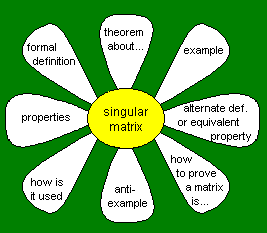
You've probably noticed by now that the flavor of things happening in class and on the homework has changed since the first quiz. That's the nature of a Linear Algebra course - we start with simple ideas and things rapidly get more complex and abstract. To help you cope with all that, I present the
There are three main areas of preparation you want to work on:
Beyond that, here is Janeba's general guideline:
|
Spend about 30-35% of your study time organizing the material in your head, and 65-70% of your time doing actual homework problems. Note 1) Organizing the material in your head should usually
consume paper and ink. |
This is the part that you are probably most familiar with: learning how to work through routine calculations. In this class, for instance, we have learned how to solve a system of equations by Gaussian elimination and back substitution, or by their close cousin, Gauss-Jordan reduction. We have learned how to convert to and from matrix form. We have just hinted at the process for computing the inverse of a matrix, if one exists. We have learned how to add and multiply matrices. We have learned a bunch of other things, too...
Of course you want to make sure you know the processes or algorithms we have learned. It is probably helpful to make a list of them, though sometimes you will have to invent your own name for a process, since we haven't always given one. The most important advice here is that the student must recognize that learning the algorithms is just a part of what one must do to succeed in linear algebra.
In some ways, you could think of this "learning area" as being similar to learning the vocabulary in a language course. First of all, you have to spend some time doing the memorization. Also, as in language, there is more to just memorizing the words (or definitions): you need to know how things fit together.
For example, take the concept of row echelon form. You need to know the definition, of course:
DEFINITION: A matrix is said to be in row echelon form
if
from Linear Algebra with Applications, Steven J. Leon, Prentice-Hall, 1998. |
...but you need to have digested this a lot, also. Knowing just the verbatim definition above wouldn't help much with a question like "Give examples of three distinct forms that the row-echelon form of a 3x3 matrix could take".
In addition to the formal definition of something, one should know:
Most importantly, you need to know how all this fits together. First of all, that's what mathematics is all about - how things fit together - which mathematicians call the structure of something. Secondly, lots of psychological research has shown that it's far easier to remember something that has some cohesive organization than something that is made up of lots of unconnected pieces. Here's an image to give you the idea:

(Most of the ideas in this section are due to David Lay of the University of Maryland. I learned them from a talk of his at the Joint AMS/MAA Meeting in Baltimore this past January. In particular, the flower-metaphor and building what he calls a concept image out of these various parts are his ideas. Professor Lay requires his students to write out all these components for each major concept in the course (though perhaps not in flower form)).
So... why doesn't Prof. Janeba just give you a list of all this stuff? First of all, I can't organize your thoughts. Secondly, if someone wants to learn how to build a house, looking at someone else's house can be a good idea, but practice will be much more helpful. So get out your hammers, and start practicing!
As you know, this is not Willamette's main learning-how-to-write-mathematical-proofs course, or at least not the first one that students take. In fact, though, all advanced math courses include this topic. Just as in calculus one might learn particular methods for computing certain integrals, in linear algebra one learns particular methods for writing proofs pertinent to linear algebra.
For example, we have learned a method for proving that one matrix is the inverse of another, i.e. for doing problems of the form:
Prove that (AB)-1 = B-1A-1 (assuming A and B are invertible) or
Prove that (AT)-1 = (A-1)T (assuming A is invertible)
Another example: we have already learned that proofs about matrices can come in two forms:
In all proofs, one must have the definitions (see Learning definitions and theorems) readily at hand. Beyond that, it will help to consciously learn the particular proof techniques that we see in class and in the readings. Making a list, in your own words, isn't a bad idea.
In all this, remember Janeba's general guideline.
Last modified February 4, 1998.
Prof. Janeba's
home page | Please mail comments or questions to: mjaneba willamette.edu
willamette.edu
Willamette University
Home Page